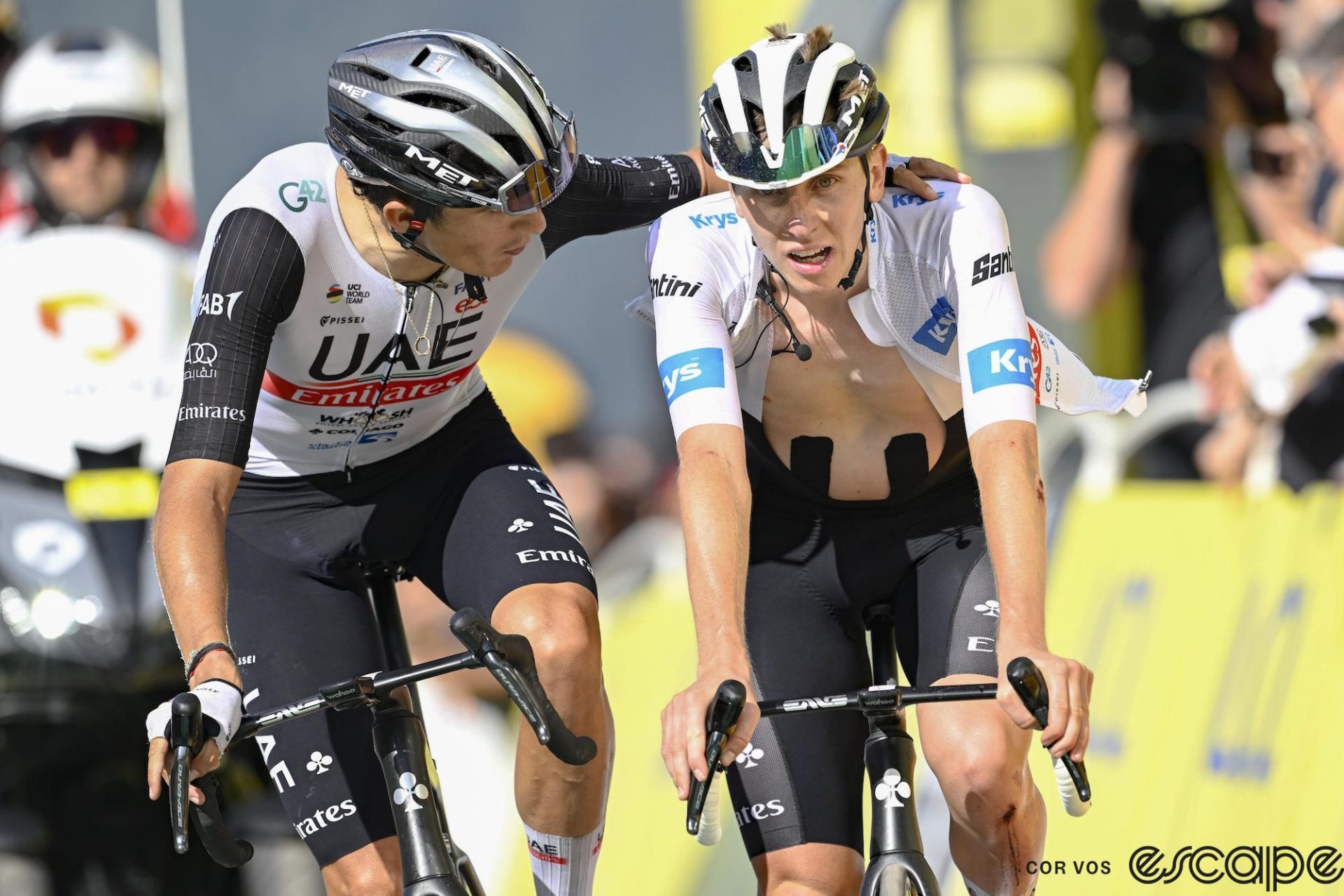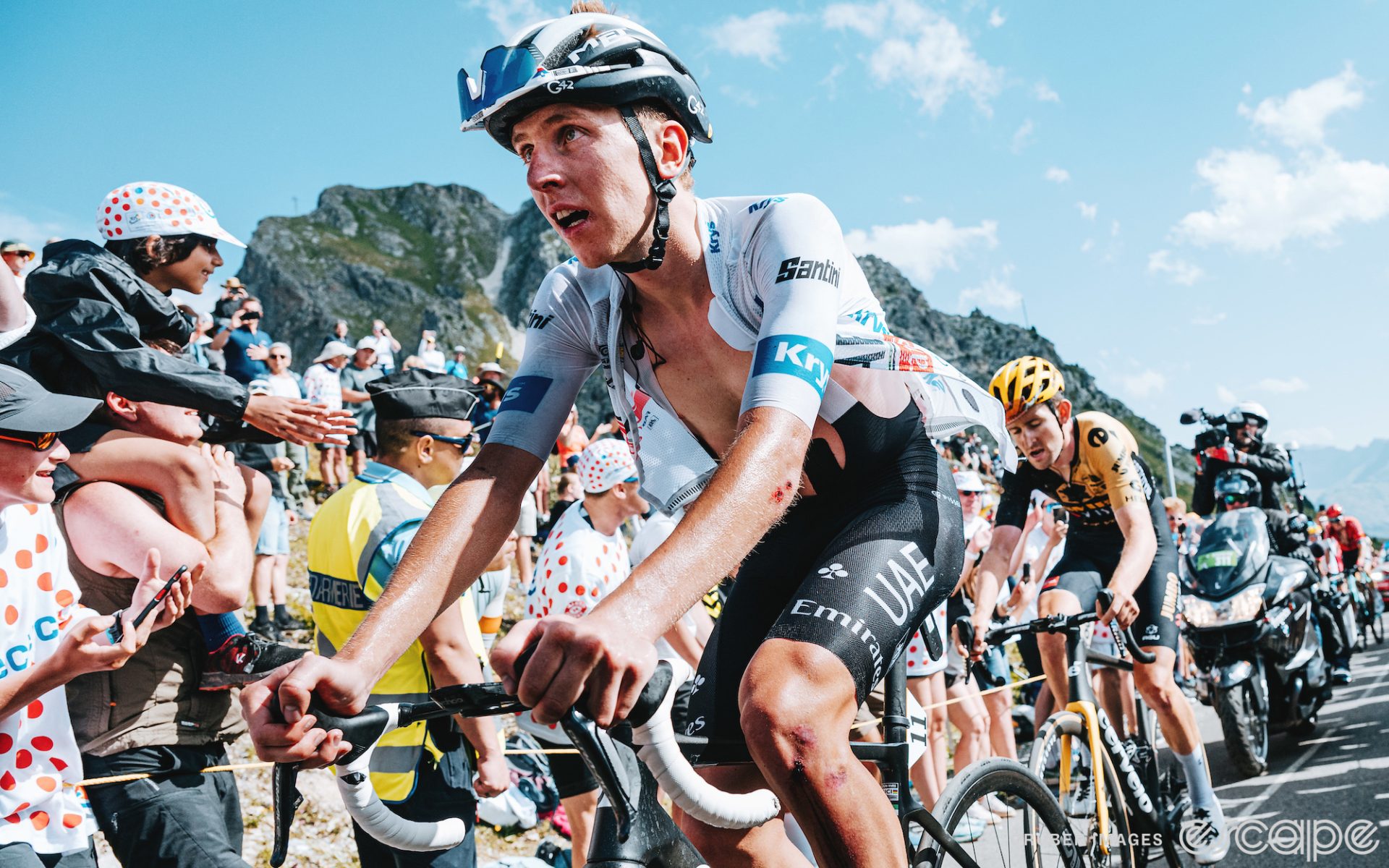Covering a bike race makes you realize everyone, I’m sure, is seeing much more than I can. I catch glimpses of riders on other journalists’ television screens. It says 20 km on the ticker. I have no idea what’s happening. I’ve been in between gondolas for thirty minutes (I am terrified of heights) and lagging behind a scramble the boys are much more adept at. Now, I am lost in the zone technique.
The zone technique is where all the television trucks are parked, interconnected with mysterious infrastructure via a labyrinth of cables. For non-TV people, this is a maze you don’t want to get lost in. At every turn we are redirected by officials who tell us to go back where the other officials said we couldn’t go. This transpires for about twenty minutes. The race is running out of kilometers and I’m stuck in what feels like a cage, a cage with televisions which have glimpses of the race and people who don’t like you looking over their shoulders. Eventually, we hop a fence. Vive le Tour.
Before that we were watching the ski jumpers practice in the valley. From where we were at the bottom of the hill, their risks seemed maddening. And yet, as each came off the ramp, they hovered in the air like perilous birds, and then made sweet friction with the earth and stopped, I thought to myself, this is how all risk is in sport. And the frog in our throats is why we keep watching ‘til the end of the jump.
On the Col de la Loze, the ski jumpers are invisible now, the houses in the valley mere dots. The infrastructure of skiing looks naked in the summertime. There is, crucially, no rain. As soon as we see pictures, before we are shooed away from the big television in favor of piecemeal again, Pogačar drops. At first it’s just lingering. Then he sinks like a stone, the space between him and everyone else opening up into a void.
His face, which once seemed impossibly young and burgeoning with endless potential, is wan and aged. He appears ill. His suffering is visceral and difficult to watch. At the same time, Felix Gall attacks off the front of a fractured breakaway. Suddenly we are working in the space between grief for one man and hope for another. Hope is gone for Pogačar. No one, at the moment, knows what to say except the Tour is over. The best Tour of the century is now only another Tour. What seemed like a long denouement is an abrupt ending. The time goes out astonishingly quickly. One minute, two. Pogačar says, over the team radio: “I’m gone, I’m dead.”
Someone says, what’s the point of watching now? He meant it about the Tour, but it fits better for the stage. It is painful watching Pogačar, a mighty opponent, reduced to this. When Vingegaard digs in and sets up the road alone, it’s even more painful. There are, I think, a lot of parallels here between the 2020 Tour – I’m fine saying that now. Watching Pogačar is as though we are watching a man die on television, or if not die, expire. We are seeing him at his worst, in all his vulnerability, his face slack, mouth open, eyes dilated. Two minutes. Five. It will be almost six at the finish.

A common theme this year is revisiting that Tour. It was revisited when Roglič, its victim, won the Giro in a way narratively similar to how Pogačar beat him, through a time trial, a process repeated between Vingegaard and Pogačar in the Tour. But there are other parallels. Pogačar, like Roglič before, was inundated with difficult questions and was the topic of the internet’s suspicion, exactly the same way Vingegaard is now. Immediately no one believed anyone could beat Pogačar, as was the case with Roglič before him, as is the case with Vingegaard now.
In the next few days, we will see lots of big statements. Vingegaard is untouchable. Pogačar is washed. Slovenian cycling is over. The sky is always falling. But the only way things can play out is how they play out. Someone can emerge who is better than everyone else. Pogačar, for his catastrophic loss, has much to rest easy about.
His season up to this point was, aside from the broken wrist, impeccable. He is a much broader rider in terms of his goals and his capabilities in different races. He also threw the fucking kitchen sink at this Tour – he made up what seemed like an impossible amount of time, pulled big punches, burned the candle at both ends. A man not so long ago seen as an antagonist has evolved into being one of the peloton’s most engaging and charismatic riders. To see him suffer is especially cruel because of his brightness.
Vingegaard, meanwhile, is still a mystery, in the way Roglič was a mystery all the way up until that grand loss, which humanized him. Vingegaard gives short answers. He doesn’t have a way with people. He is not a laughy-jokey kind of guy. One looks at him and can sense that he wants to disappear. He and Pogačar could not be more different people.
Back in the race, Simon Yates hunts down Felix Gall. There is no longer even a camera on Pogačar. Traffic in the road caused by spectators is the only thing that’s stopped Vingegaard. The sound of the helicopter. Gall manages to hold on, a stunner of a day out by a rider who has emerged from the background as a rising force over the last few weeks. Because every day has turned, in one way or another, into a GC day, the fall of Pogačar is a silver lining for those hoping to go up the road the rest of the week. A tree falls after a century so that the sun may shine on all its saplings.
I don’t see much of any of this as it unfolds in detail lost on me. I’m standing watching the riders come in, knowing and seeing little. After a climb as long and as hard as Col de la Loze, everyone who comes in appears fragile, as though they could collapse at any second. They are surrounded by television crews, whisked off to anti-doping, handed cans of soda, but they are not all there. They have gone deeper into themselves than most of us can ever imagine.
I think this is what we love about cycling, deep down. There is very little that is genuine in public life. We lie all the time about how fine things are. We hide our feelings including some of our most existential. We push through our exhaustion and everyone else does too and we all pretend that this is normal.
But in cycling, their suffering feels real. It is total, physical suffering evidenced in their expressions and in what they do. When we look into it, it cannot be rationalized away. Weakness is made manifest and not only that, it transforms into a strength. You endured. When those riders feel impossibly strong, any weakness hits even harder, makes us nervous about our own resiliency, our own lives.
We all watch the ski jumpers in rapture, but want to look away when they get wobbly in the air.
What did you think of this story?

